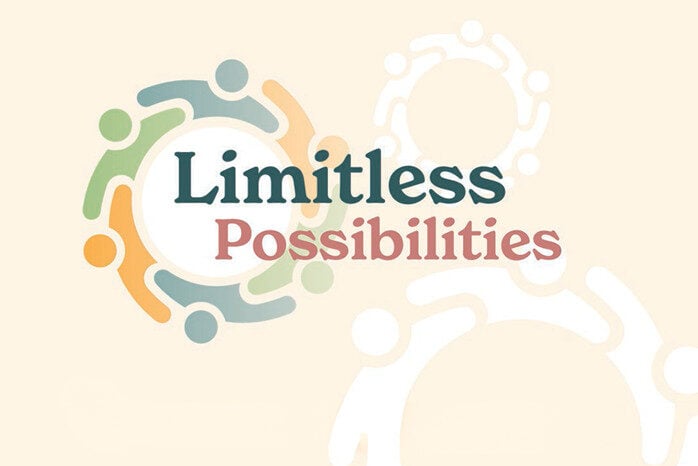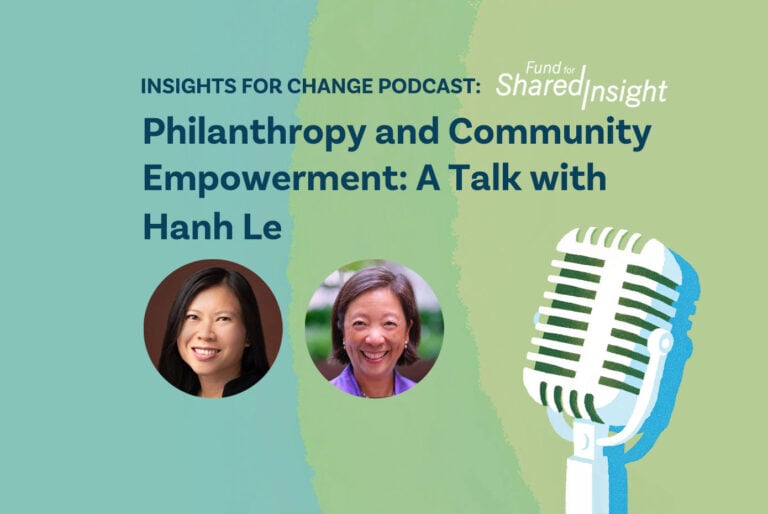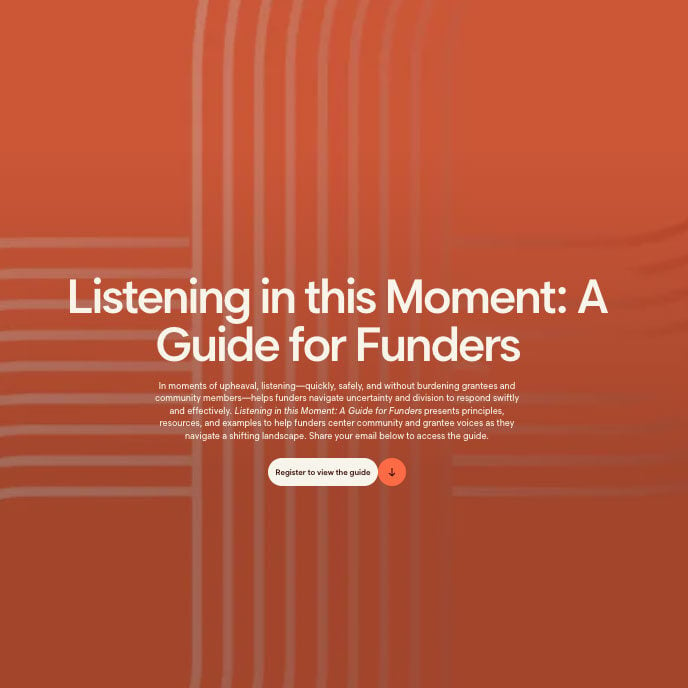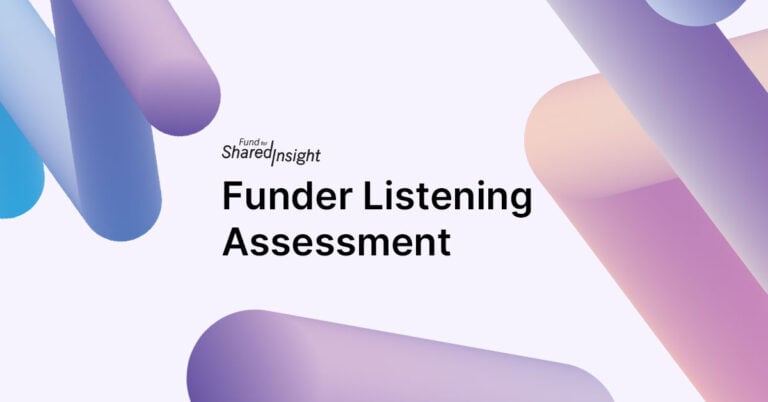As part of Fund for Shared Insight’s ongoing series about funder listening tools and resources developed by other organizations in the field, we invited Engage R+D to introduce their resource for funders ready to integrate participatory learning into foundation practice.
The James Irvine Foundation envisions a California where all low-income workers have the power to advance economically. This vision guides the foundation’s grantmaking, partnerships, and learning, with the belief that all Californians — regardless of who they are, where they live, or how they came here — deserve opportunities to create better lives for themselves and their families.
As part of its commitment to this vision, Irvine has embraced participatory learning. Engage R+D, the foundation’s long-standing learning partner, defines participatory learning as the deliberate inclusion of grantees and community leaders in foundation-supported learning activities to share power and decision making.
Both Irvine and Engage R+D believe deeply in the power of participatory learning and have seen its benefits. Among other advantages, participatory learning enables funders to:
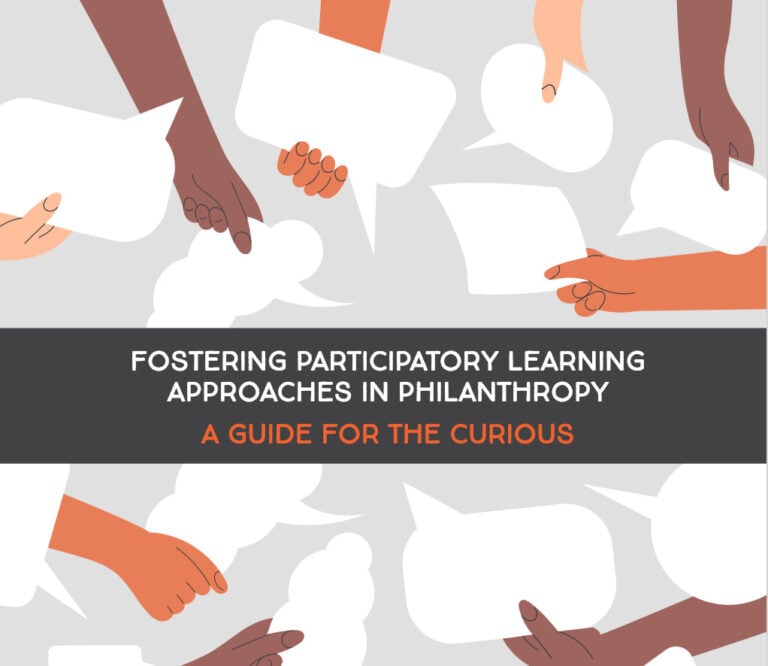
- Cultivate trust and alignment with grantees and community members;
- Demonstrate a commitment to equity;
- Enhance foundation adaptability and learning through more open dialogue; and
- Turn data collection into actionable insights by elevating grantee and community perspectives in the learning process.
Building on this belief, Engage R+D, with the support of Irvine and other funders, published Fostering Participatory Learning Approaches in Philanthropy: A Guide for the Curious, in 2024. The guide, which draws on interviews with a range of funders, provides practical tools to help foundations assess their readiness for participatory learning and navigate this approach with care and intention.
The value of reflection
Participatory learning is not a one-size-fits all approach — it requires ongoing reflection, adaptation, and a willingness to navigate challenges. In implementing this approach, funders may face tensions as they work to prioritize grantees’ learning priorities as well as their own, align participatory learning with internal strategies, and rethink traditional institutional decision-making processes.
When funders recognize these realities at the outset, they can better anticipate challenges and approach participatory learning with thoughtfulness and resilience. While there is no perfect time to begin, getting started with a clear purpose, openness to learning, and a commitment to doing no harm is essential.
Irvine’s participatory learning journey has focused on listening and learning from its grantees. While some participatory approaches involve direct engagement with community residents, others can center on grantees —organizations that have deep roots in their communities and actively engage with residents and the issues they face.
Irvine has prioritized working closely with grantees to inform its learning and decision making, recognizing their role as trusted partners with direct community connections.
This blog post tells the story of Irvine’s participatory learning journey, highlighting key moments of reflection, adaptation, and growth. At each stage, we note relevant tools and resources from Engage R+D’s recent guide to support funders who may be navigating similar points in their own participatory learning journeys.
Irvine’s participatory learning journey
Irvine’s leadership and staff strongly supported engaging grantees in participatory learning approaches as a natural extension of the foundation’s commitment to equity and collaboration. But implementation brought challenges. Experimentation, adaptation, and a willingness to pivot based on grantee feedback are essential to successfully implementing this approach. However, developing this muscle takes time.
As Irvine worked to deepen its partnerships with grantees, it took intentional steps to strengthen its participatory learning practice, including:
Piloting participatory learning
Irvine experimented with different participatory learning strategies, recognizing that a single approach wouldn’t work in every context. Still, Irvine underestimated several important factors, including that:
- A history of collaboration mattered. The level of prior partnership between Irvine staff and grantees influenced how quickly and well participatory learning efforts could take root. In some cases, Irvine and its grantees needed more time to build trust before reaching a deeper level of engagement.
- More space for reflection and adaptation was needed. In some cases, pilot efforts moved through implementation without pausing to assess whether approaches were resonating with grantees or if grantees or staff needed additional technical support.
- Readiness varied across the foundation. Some teams jumped into participatory learning before fully understanding how much grantee engagement was the right fit for their work, leading to challenges in balancing staff capacity, organizational culture, and expectations.
In hindsight, Irvine reflected that had a resource like the Readiness Assessment from Engage R+D’s recent guide been available at the outset, it could have more proactively assessed these dynamics, refined its approach earlier, and helped avoid or minimize some of the challenges the foundation experienced.
Helpful Resource: Readiness Assessment (pages 8-9 in the guide)
Navigating tensions between foundation and grantee learning priorities
Irvine has worked to increase grantee involvement — engaging them earlier in the process to co-develop goals for its grantmaking initiatives, define and measure success, and shape learning questions that inform and strengthen the work. Initially, the foundation sought to align around a single set of learning priorities that both grantees and Irvine staff agreed upon. Over time, however, it became clear that grantees and funders often have distinct learning interests, and that these priorities can coexist rather than compete.
For example, in one participatory learning effort, Irvine prioritized grantees’ learning needs as part of an evaluation. Later, the foundation determined that some of these learning questions would need to be addressed separately or deprioritized in favor of internal needs. This shift underscored a real-time challenge: a funder’s intent to share power often clashes with the complexities of doing so in practice.
Irvine continues to reflect on how to best navigate these differing priorities and has found that being transparent from the outset — about what the foundation is interested in learning and where grantee priorities may differ — is essential to foster trust. Acknowledging this openly allows for more constructive dialogue and enables grantees to better understand how funders evaluate outcomes and make grantmaking decisions.
Helpful Resource: Participatory Learning Benefits Foundations (pages 11-13 in the guide)
Creating equitable and consistent compensation approaches
As Irvine expanded participatory learning practices across the organization, it recognized that adopting a uniform approach to compensating participants would ensure fairness. Previously, different staff determined compensation amounts on a case-by-case basis, leading to inconsistencies. Adopting a uniform approach not only promoted fairness across initiatives but also improved efficiency by eliminating the need for staff to create new compensation structures for each learning effort.
Helpful Resources: Considerations Checklist: How to Compensate Participants Fairly (page 31 in the guide); Budgeting tips (bottom of page 19 in the guide)
Testing assumptions of grantee burden
Irvine staff were broadly supportive of participatory learning, recognizing its value in strengthening partnerships and centering grantee perspectives. However, as they began implementing these approaches and better understanding what participation would entail, some program staff expressed concerns about placing an undue burden on grantees — even when compensation was provided. Staff raised these concerns out of a desire to be mindful of grantees’ time and avoid unnecessary engagement.
To test these assumptions, Irvine gathered direct feedback from grantees who participated in these processes. Their responses revealed that, while participatory learning required time and effort, they generally found the opportunity to collaborate with peers and shape learning and grantmaking efforts to be worthwhile. This feedback not only provided valuable insights for staff but also helped shift perceptions of burden, fostering greater confidence in the approach.
Helpful Resource: Tips for Successful Participatory Learning (pages 27-30 in the guide)
Sustaining ongoing leadership support
Irvine’s participatory learning efforts are grounded in the belief that those most proximate to social challenges hold critical insights into solutions. This belief aligns with the foundation’s broader values and priorities championed by its CEO and board. Irvine’s attention to aligning its participatory learning efforts with its organizational and equity values has been critical to securing ongoing leadership support, allocating the time and resources to deepen this work, and embedding participatory learning as an ongoing practice rather than a one-off effort.
Helpful Resource: Reader Reflection Questions (page 21 in the guide)
Looking ahead: Call to action
Participatory learning represents a shift in philanthropy — one that acknowledges that those closest to social issues should play a role in shaping solutions. This approach fosters more equitable, transparent, and responsive relationships between funders and grantees.
At the same time, participatory learning is an evolving practice. As the Irvine Foundation’s experience shows, there is no perfect formula, and challenges will arise. However, by embracing intentionality, reflection, and a commitment to learning from grantees, funders can take meaningful steps toward more inclusive and impactful philanthropy.
We invite you to share your own experiences with participatory learning — what has worked, what challenges you’ve faced, and what you’re learning along the way. Let’s continue this conversation together.
About the authors:

Anna Saltzman



